For Nick Gartside, international CIO within JP Morgan’s global fixed income group, however, the question should be how one accesses the fixed income space rather than whether or not to be invested.
“In one sense, it is a relative game,” he says. “If you look at the high yield space, yes yields are low, but they are also low everywhere else. If you look at the spread between high yield bonds and government bonds however, that looks okay right now.”
For Gartside, one of the key questions at the moment is how best to access that spread. “One of the ways we have been doing this is by buying the high yield bonds and selling government bond futures in order to isolate the spread.”
Asked about the concerns raised about the high yield space, in particular about the levels of liquidity in that market, Gartside says currently, liquidity is not of especial concern. The risk is that default rates go up, he says, but adds that default rates have, so far, been low and, in JP Morgan’s view, are likely to stay that way in the short term.
The other area of interest at the moment, according to Gartside is the unconstrained bond space.
“There is an intellectual inconsistency within bond benchmarks, in that they tend to reward bad behaviour. By choosing an unconstrained fund you are basically doing away with this and trying to invest in only the bits that you think are going to go up.”
But, he cautions, it is important to ensure that the fund chosen actually has a truly global opportunity set.
















